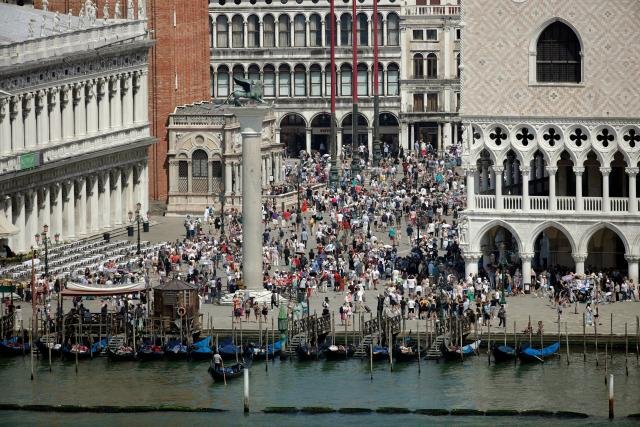Venice, a UNESCO World Heritage Site renowned for its historic canals and islands, is implementing new measures to regulate tourist influx and protect its residents. The city plans to cap tourist groups at 25 people, reduce the use of loudspeakers to minimize disturbances, and introduce a day-tripper entrance fee during peak days between April and mid-July.
The move comes in response to challenges posed by heavy tourist traffic, particularly from day-trippers who do not significantly contribute to the city’s economy. Venice aims to address issues like overcrowding in St. Mark’s Square, which led to bridge congestion and overflowing trash cans during the summer. In 2022, 30 million people visited Venice, but only 3.2 million stayed overnight in the historic city center.
To manage day-tripper numbers, Venice will trial a €5 ($5.44) entrance fee during specific peak days. Visitors must register online, download a QR code, and may face fines if found without the code. The city hopes these measures will alleviate pressure on its infrastructure and enhance the overall experience for both residents and tourists.
Venice’s decision to implement entrance fees for day-trippers follows a global trend among popular tourist destinations. In 2021, Amsterdam increased its tourist tax by 12.5%, making it the highest in Europe. Similarly, Hawaii considered a $50 pass for tourists to access the islands’ natural beauty. The rising trend of tourist fees reflects concerns about overtourism, environmental impacts, and the need for additional revenue, especially after the economic challenges posed by the COVID-19 pandemic.
Jason Block, CEO of WorldVia Travel Group, notes that tourist taxes are widespread and often take the form of lodging taxes automatically added to hotel bills. Many destinations are increasing these fees to cope with rising demand. Additionally, some places are introducing entrance fees or electronic visas to manage tourist numbers more effectively.
While these fees may initially seem inconvenient, Block emphasizes that the funds generated from tourist taxes are often reinvested into the destination. These funds contribute to improving local infrastructure, ensuring a better travel experience, and supporting sustainability initiatives. For instance, Iceland increased its accommodation tax to protect its environment and work toward carbon neutrality by 2040.
The impact of tourist taxes on travelers varies, and there is a growing concern about transparency. Travelers need to scrutinize the breakdown of airfare or hotel costs to understand the full extent of fees. Although individual fees may seem small, they can accumulate significantly over the course of a trip for families or groups. While some travelers support these fees as contributions to destination sustainability, others worry that increased fees could limit accessibility for budget-conscious travelers.
Venice’s decision to implement entrance fees and regulate tourist numbers reflects a broader shift in how destinations are managing the challenges of mass tourism. As the demand for travel intensifies, many popular destinations are exploring various forms of fees to balance economic benefits with environmental and infrastructural considerations. Travelers are advised to stay informed about destination-specific fees and factor them into their travel budgets to avoid surprises during their trips.
Book Paris Trip
Paris sightseeing
Book Paris activities
Louvre museum paris
Paris limousine rental
Rolls Royce Paris
Eiffel Tower Paris
Airport Transfer Paris
Book Paris Taxi
Seine River Cruise
Wine Tasting Paris
Paris luxury hotels
Switzerland luxury hotels
Europe Car rental
Europe coach rental
Paris Limousine
Dior Paris
Beauvais Airport transfer
